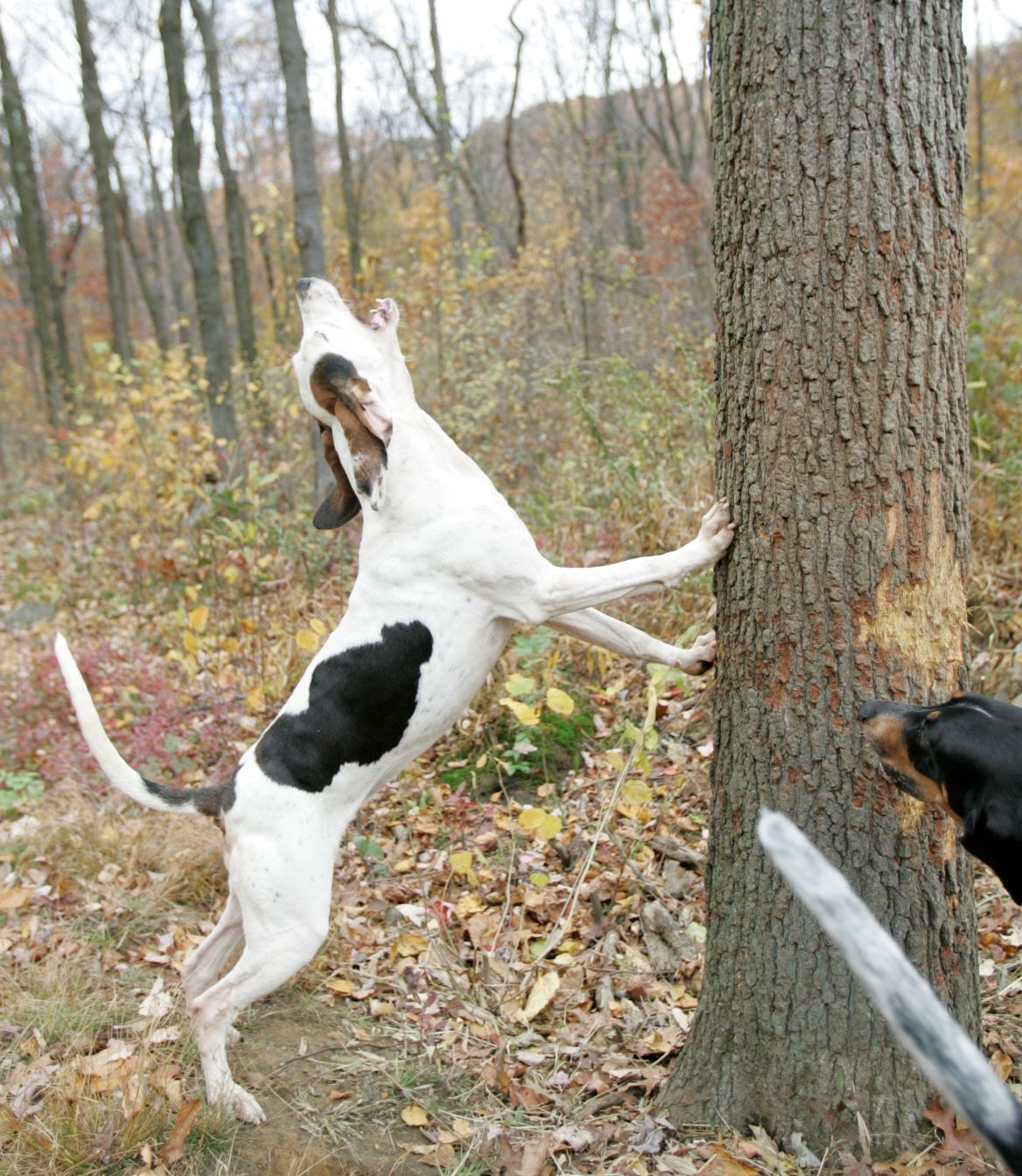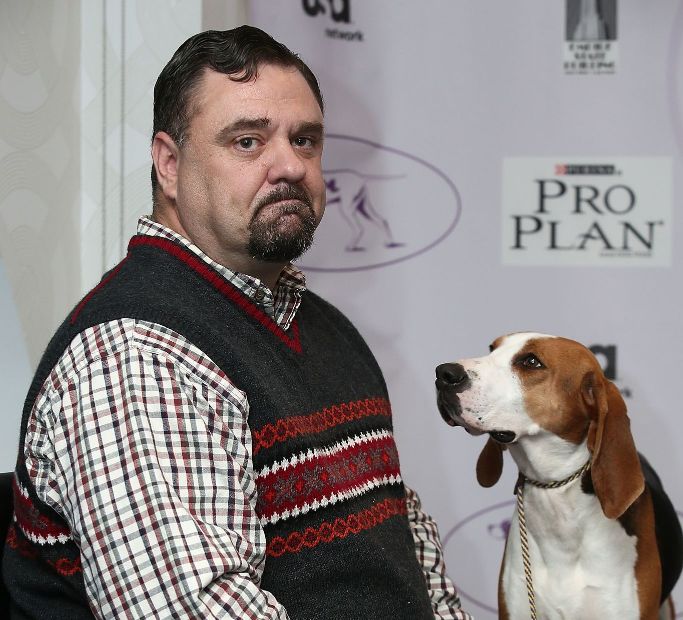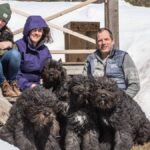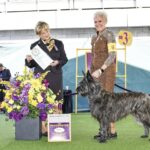Treeing Walker Coonhound | One More Chase Through the Woods. Can anyone tell me what geography, tyranny, the Declaration of Independence, and the most dominant hound ever developed to chase fur-bearing critters through the forest of America have in common? If you guessed “the Bluegrass State of Kentucky” then you are absolutely right.
The Fifteenth State
Kentucky became the 15th state in 1792 after spending a great deal of time as part of a large land grant called Virginia. In 1609, when King James I established Virginia, this area covered from what is now known as North Carolina in the south to Maine in the North, with the western boundary basically to infinity or the Pacific Ocean. The land was given to the Virginia Company as a private entity and would be managed as a company. This sizable grant would be amended in 1612 and revoked in 1624. Following in King James’ footsteps, his son, King Charles I, would continue to restrict colonial borders as well, but it was not until 1665, under King Charles II, that the North Carolina/Virginia border would be set at 36 degrees 30 minutes north latitude. This line of demarcation would carry west to the Kentucky/Tennessee border in the mid-1700s as well. Using a straight line as a land boundary wasn’t a completely new endeavor. However, it was not an exact science in colonial times and geographical boundaries were far more typical. This 36-30 boundary would cause numerous disputes during this time. Finally, men from each state would form a team to survey the boundary once and for all.
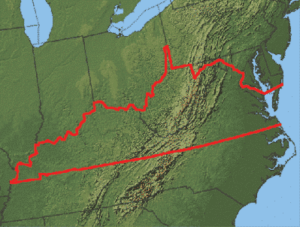
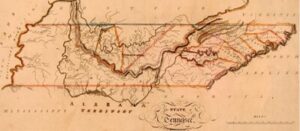

In 1728, a team led by William Byrd started at the Atlantic Ocean and made it 241 miles west before rattlesnakes and the summer heat required them to stop. This was approximately two-thirds the way across. Twenty-one years later, in 1749, a second team led by Peter Jefferson and Joshua Fry would pick up and take the line further west to just east of Bristol, Tennessee. Peter Jefferson, Joshua Fry, Thomas Walker, and Edmund Pendleton formed the Loyal Land Company and secured an 800,000 acre tract of land along the Virginia, Kentucky, and Tennessee borders. This tract of land would later become a bit of a headache to Peter Jefferson’s son, Thomas.
In 1763, King George III would take back this land grant and place the area west of the Appalachians under the governance of a new province named Quebec. Quebec was won from the French during the “Seven Years’ War.” This did not sit well with the Colonies, as one might imagine. Along with the increased taxation, the Revolutionary War was upon us. This bothered our forefathers so much, in fact, that Thomas Jefferson saw fit to include the following sentence in the Declaration of Independence:
“For abolishing the free System of English Laws in a neighbouring Province, establishing therein an Arbitrary government, and enlarging its Boundaries so as to render it at once an example and fit instrument for introducing the same absolute rule into these Colonies…”
As you can see, surveying of land parcels was a very important job in colonial days and even after the Revolutionary War, in fact. Thomas Jefferson would enlist the services of family friend, guardian, and Loyal Land Company owner Thomas Walker to pick up where Peter Jefferson had left off and continue the surveying expedition of what is now the Kentucky/Tennessee border.
THE LEGACY OF THOMAS WALKER
Thomas Walker was a physician and an explorer. He had explored what is now the Allegheny mountains, named the Cumberland River, and explored present day Kentucky nineteen years BEFORE Daniel Boone. As head of the Loyal Land Company, Walker had secured a land grant of 800,000 acres in what is now Southeastern Kentucky. He led an expedition to survey this land in 1750. Following the Revolutionary War, in fact, even after Thomas Jefferson became President, the boundary between Kentucky and Tennessee was still in dispute. At the age of 64, Thomas Walker was again commissioned to survey the boundary in question and establish what became fittingly known as “The
Walker Line.”
Louisa. That is the name that Dr. Thomas Walker gave to the land the Native Americans called Ken-tuck-E. He would name the Cumberland River and the Cumberland Gap, which would later be the porthole into the expansion west of America, known as the “Wilderness Road.” An excerpt from his personal journal would show that along with the supplies for his exploration, Dr. Walker, an avid hunter, would also take along a pack of dogs to help feed the party.
“Two of their horses were bitten by snakes, which I successfully treated with bear grease. One horse choked on reeds that grew along the streams, and I drenched its throat with much water. One dog was badly injured in a fight with a bear, and was carried on horseback for seven days—until he was able to travel.” – Excerpt from
Dr. Walker’s Diary
This love of hounds and hunting would be passed on to his 12 children, grandchildren, and so on. These descendents would settle in North Carolina, Tennessee, Kentucky, Virginia, and Missouri, but it is the Kentucky Walkers who are given credit for the development of the Walker hound.
Joseph B. Thomas, M.F.H. of Middleburg, Virginia, wrote the first comprehensive book on hound hunting in the United States. Published in 1928, his Hounds and Hunting Through the Ages is a treasure trove of information on the development of the Walker hound. We know from our own Treeing Walker history that John W. Walker and George Washington Maupin, known as Wash, owned a great pack of foxhounds in what is now Garrard County, Kentucky. Their pack was known for its great speed and ability to run fox to the ground. Running to ground meant that the pack would put so much pressure on the fox that it would be forced to find a hole, a place of refuge, or die. We also know that along with the influx of settlers to Kentucky, the imported Red Fox would make its way west as well. The Red Fox, which is bigger and faster than the indigenous Gray Fox, would soon put the pack to a test that would see them fail more often than not. An excerpt from Hounds and Hunting Through the Ages would tell of Walker/Maupin’s endeavors to speed up their pack:
“In the early fifties (1850s), General Maupin and his friends imported many dogs from South Carolina, Virginia, and Maryland, sparing no expense to improve their stock. In 1857, they imported from England, I think, three dogs, Fox, Rifle, and Marth. About this time, General Maupin got from east Tennessee the dog, Tennessee Lead, which he, Maupin, thought the best he ever owned.”
These men went to the ends of the Earth to produce a dog that could run a fox to ground, and as you can tell, money was no object. The story of Tennessee Lead is known to ALL Treeing Walker enthusiasts as it is not only the foundation stone for which our breed was built, but also a metaphor for the people who today enjoy the fruits of Lead’s progeny. For those who don’t know the story of Tennessee Lead, I will briefly discuss his “acquisition.”
Tom Harris was a drover. He would drive livestock from Tennessee to Kentucky and back, as well as haul merchandise. On a return trip from Tennessee, Tom heard a pack of hounds chasing a deer. He was in the mountains, just south of the Obey River basin, when one hound could be heard well ahead of the rest. Harris, a consummate salesman who knew his clientele well, would catch this dog and deliver him to Madison County, Kentucky, where George Washington Maupin bought him, bred to him, and forever marked the evolution of the American running hound. The dog, known as
Tennessee Lead, did not look like the foxhounds of the day. He was a small, black and tan-colored dog with a rat tail. What he lacked in looks he made up for with speed, drive, and game sense. His clear, short mouth was easy to hear, but his ability to reproduce was why he was bred to all of Maupin’s and Walker’s top bitches. Turning to Joe Thomas’ book:
“The cross of the English dogs, and especially the Lead cross on their previous importations, produced a dog which has justly become famous and has become known as the Maupin dog. This strain has been preserved and bred with great care by WS Walker and Brothers, of Garrard County, Kentucky, and are known today as the Walker dogs.”
A Distinctive Hound
By 1868, the Maupins had a very distinctive hound. This type would be preserved firstly through the efforts of Jason Walker, as 1868 was the year that Wash Maupin would die. From 1870 on, we are completely indebted to the Walker brothers. WS, Arch, and Wade Walker’s records would show that the dogs were sold to people in Texas, Missouri, Tennessee, and throughout the South by 1900. With the turning of the century came a new sport to play with hounds; the field trial. It was these field trials, and later, nite hunts, that would take these “Walker Hounds” from the Foxhound packs of the well-off into the hard-working hands of the common man.
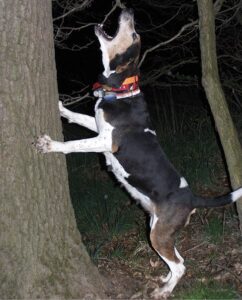
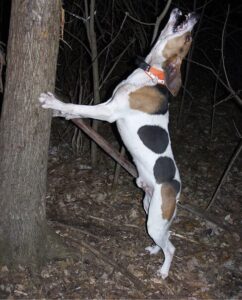
Speed, Speed, Speed. By and large, humans are competitive. And that competitive spirit is strong within the ranks of coonhound enthusiasts. At the beginning of the 20th century, this competitive spirit would see the sport of field trialing thrive. While no one knows where and when the first coonhound field trial was held, there were a great many held in the 1920s-‘50s, covered by Mountain Music Magazine, Full Cry magazine, Hunter’s Horn magazine, and The Chase magazine—so we have a good idea of how popular these events became. Today’s field trials are hundreds of yards in distance, but the early field trials could span as many as seven MILES in distance. In a March 1942 Full Cry article, Harry Andrews gives credit for the first field trial to George Slatzer of Marion, Ohio. This event may very well be the first advertised field trial, but earlier writings show that many clubs held “challenges” well before the summer of 1924. Regardless of who gets the credit, the field trials would soon bring coonhunting to the forefront of America’s dog-related pastimes. The winner of “Dad” Slatzer’s field trial was “Bones,” a UKC-registered English Coonhound owned by Col. Leon Robinson. Bones was considered a Bluetick in his day, but all foxhound-related breeds were registered under the English Fox & Coonhound banner during this time. A quick look at Bones, and any present-day English Coonhound breeder would be proud to own him. With his victory, the $50.00 purse, and the subsequent coverage of his feat, the sport of field trialing would take hold and dominate the sport of coonhunting for over 30 years. Following in Slatzer’s footsteps, Col. Hank Pfeiffer would organize a $1,000.00 event to be held in May of 1927, called Leafy Oaks. Leafy Oaks would also be sanctioned by the United Kennel Club and would draw hundreds of dogs from around the country, with the majority being from Ohio, Indiana, Michigan, and Pennsylvania. With the success of these events, Chauncie Bennett would see dollar signs, and UKC would flourish as it began registering these hounds. At the time, UKC registered only three breeds of coonhound; the Black & Tan, the Redbone, and the English. ALL were registered as Fox & Coonhounds at the time. One of the first Leafy Oak winners was “The Sheik,” the product of a Redbone bitch bred to a Walker dog. The Sheik was registered with UKC as a Redbone. Another big Leafy Oak winner was “The Ghost” whose dam was a B&T and whose sire was a Walker. The Ghost was registered as an English Coonhound. I mention this just to show you how much impact the Walker hound was having on UKC even 20 years before they would become fully recognized. Leafy Oaks would spawn the Kenton Nationals and numerous other large pursed field trials, and the coonhound fraternity would feel the boom of prosperity.
Another great field trial event, the Tree Top Field Trial, was held the second Sunday in August in Niagara Falls, New York. The first Tree Top event was held in August of 1930 with a guaranteed purse of $300, which in 1930 was quite a sum of money. It would grow to become a coonhound carnival with a $600 purse in 1934, its fourth and final year. Regulars at this event would include the Smith brothers who were originally from Kentucky but would move to Ohio and bring their Walker-bred hounds along with them. These brothers would win one of the first Leafy Oaks with a hound called “Red Fox” (as well as win First Line at the 1933 Tree Top with Red Fox), and his kennel mate, “Leapin Spider,” would win First Tree money at the same event. From 1931-1933, the Smith brothers and these two Walker-bred hounds would win the small fortune of $2,500.00. With that kind of money at stake, coonhounds would grow in value from $25.00-$35.00 to well over a $100.00—and sometimes even $300.00. Thus, the business of breeding champions to champions began, and anything with a magical shot of “Walker power” was in high demand.
Mountain Music Magazine started on December 21, 1931 and touted itself as the National Fox, Wolf, and Coonhound Journal. A.B. Hartman was the editor and publisher as well as the owner of the Mountain Music registry. To register your hound, you needed only to send in the dog’s pedigree with a brief description of the dog and $.50. This was later raised to $1.00. Triggs, Walkers, Redbones, B&Ts, etc., were all registered with the Mountain Music registry and were often advertised in the magazine complete with the MM#. One such Walker was “Big Stride.” Owned by Kentucky breeder Samuel L. Wooldridge, Big Stride was considered to be the best hound of his day. On Big Stride’s grave marker, the following was inscribed: “Opinions Die; Records Live.” Mr. Wooldridge would hunt Big Stride in several of the Ohio field trials during the 1920s with great success. Daughters of Big Stride would win the 1925 and 1926 National Foxhound Trials. His ability to reproduce was unmatched during his time, but the reason he is important to Treeing Walker enthusiasts is because of a dog called “Brays Speed.” In 1927, Brays Speed was purchased by Herman Bray for $75.00 from Glenn Walsh. Mr. Walsh had acquired Speed from some foxhunters he knew after witnessing Speed fall out of a nighttime foxhunt and tree a raccoon. Brays Speed was of Big Stride breeding and was the prototypical Walker dog. He would be bred to “Foland’s Queen,” another Walker hound, in January of 1932. Foland’s Queen was sired by a Walker hound by the name of “Ring” that ran loose in a small southern town in Ohio. Duke Shell, a traveling salesman for a tobacco company, would pick Ring up and ship him to his brother Perry in Perkinsville, Indiana. No one in the town would claim old Ring, so I guess you really couldn’t call him stolen. (However, no one was ever paid for him either.) He was whisked away to Indiana, and the Shell brothers would enjoy many nights hunting raccoon with Ring. He would also be bred to several local females, producing some outstanding coonhounds. The Speed x Queen cross of 1932 would produce a litter of 12 puppies. Lester Nance of Arcadia, Indiana, would purchase two of the pups. One pup, a female, would be run over and killed. Mr. Bray kept two pups as well, one of which he named “King.” At eight months of age, Lester Nance would purchase King from Mr. Bray… and the story of White River King would begin.
TWO ‘BIG-TIME’ PROMOTERS
Lester Nance was born in 1912 and always had a fondness for hunting dogs; bird dogs, foxhounds, coonhounds, and rabbit dogs. If it pursued game, Mr. Nance was a fan. Lester Nance went on his first coonhunt in 1926 with Charlie, Glenn, and Floyd Newby and their Bluetick hound, “Queen.” Along with Queen were several other hounds, including Charlie Newby’s Lead dog. (Must have been a great night, as Lester Nance would continue to coonhunt for the next 50 years.) During King’s lifetime, Lester would use him on raccoon as well as fox, but King was known best as a coonhound. Over the next 10-12 years, King would be bred to the best bitches available in an effort to lock in this “treeing” instinct. It was Lester Nance, and a small group of men, who would go to UKC and AKC in the early 1940s in an effort to have these Walker hounds registered as their own breed. Neither UKC nor AKC were interested at first, as these hounds really weren’t breeding all that true to type and because the Walker type dogs were already being registered under the blanket English Fox and Coonhound breed. In many instances, the dogs didn’t even have three generations of pure breeding. With those doors being closed, Mr. Nance and Raymond Motley would use their influence with Full Cry magazine to get them to register Treeing Walkers for the first time. The Full Cry registry had been registering Walkers and other foxhound breeds for a number of years and had started to register coonhound breeds in late 1940. Bill Harshman would serve as the head of the Full Cry Kennel Club. Around this time, the Mountain Music registry would begin hosting coonhound events as well. These would become a series of events called the Mountain Music Hunts, and were spread across the US from Oklahoma/Texas to Ohio/Pennsylvania.
In 1945, Dr. Fuhrman, Chauncie Bennett’s son-in-law, would take over UKC. Dr. Fuhrman could see the advantage of adding what was becoming a very popular type of hound to his registry, and he set a meeting with the newly formed Treeing Walker Association and the Bluetick Coonhound Association. The meeting was held at the home of Floyd Reeder in Logansport, Indiana. Treeing Walker enthusiasts in attendance were Floyd Reeder, Les King, Lester Nance, Charlie Lord, and Russell Baker. At the conclusion of this meeting, and at the next subsequent meeting, Dr. Fuhrman decided that he would register these dogs as English Coonhound (Walker treeing). Floyd Reeder was the man responsible for the first Treeing Walker breed standard. This wasn’t exactly what these men had envisioned (and the first Treeing Walker Days wouldn’t be held until September of 1951), but it was the start of what would become the most dominate coonhound breed ever.
Raymond Motley had been breeding Treeing Walker Coonhounds since the 1920s. His strain of coonhounds was derived from Walker foxhounds solely. Mr. Motley’s first “straight” coonhound was a Walker named “Mike.” He purchased Mike in the early 1920s for $35.00. His second coonhound would be a female Walker that he found while coonhunting one night, and she was caught in a fence. From this point on, all of Motley’s hounds would be of the Walker variety. In Lester Nance’s Treeing Walker History and Memories, Lester is quoted as saying:
“Beyond a doubt, the Motley-bred bloodline of Treeing Walkers deserves a lot of credit for the foundation blood of the outstanding Treeing Walkers of the present era.”
Motley’s “Major” can be found in many of today’s Treeing Walkers. Both Raymond Motley and Lester Nance were two of the most influential Treeing Walker breeders in the early years and were the first “big-time” promoters of the breed.
These Nite Hunts were true tests of a coonhound’s ability, the handler’s knowledge of the sport, and the breeder’s ability to make successful matings.
NITE HUNTS & DOG SHOWS
Ingraham, Illinois, would become ground zero for UKC’s venture into licensed Nite Hunts. It was here, in 1954, that they would sponsor their first event. This event would be won by Plotts by the names of Overbeck’s Lucky and Branderburg’s Big Lucky, while third place would go to Lester Nance with the new Treeing Walkers. As I stated earlier, many local clubs were holding “Wild Coon Hunts” prior to 1954, but with the backing of UKC, ACHA, and other respected registries, the Nite Hunts would soon take off in popularity. These Nite Hunts were true tests of a coonhound’s ability, the handler’s knowledge of the sport, and the breeder’s ability to make successful matings. The popularity of the sport would see the kennel names of Finley River, House, Lone Pine, Yadkin River, and Spring Creek rise to the top of the Treeing Walker kingdom. And with the rise in popularity, so too came a rise in sponsorship. Today’s Treeing Walkers can hunt for purses in the $25,000.00 range as well as for new trucks in the $50,000.00 range. The great sires of the Treeing Walker breed have sired from 1,800 pups to 5,000 pups, and the influential dams have whelped litters with a 60 percent success rates in achieving hunting titles. Now, with the Treeing Walker’s inclusion into the AKC Hound Group, the Treeing Walker will come in from its “nite” time activities and be shared with the millions of Americans who tune in to watch dog shows on TV.
And as the lights dim and the crowd shuffles out of Madison Square Garden, following the conclusion of another Westminster Kennel Club dog show on a cold February night, somewhere in America a Treeing Walker is being cut loose to give Mr. Ringtail one more chase through the woods.



